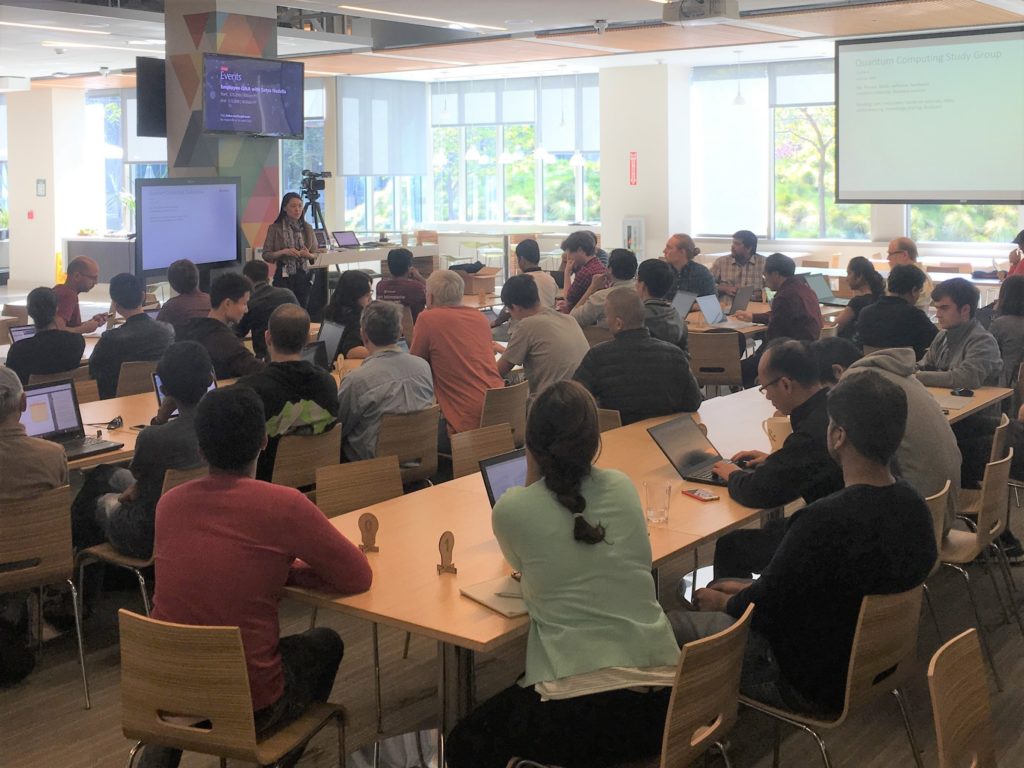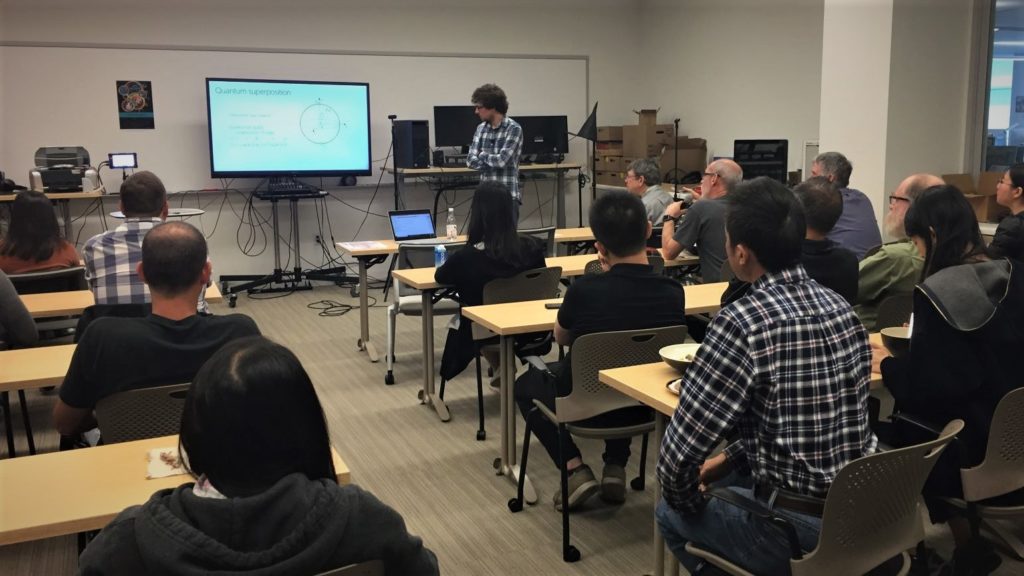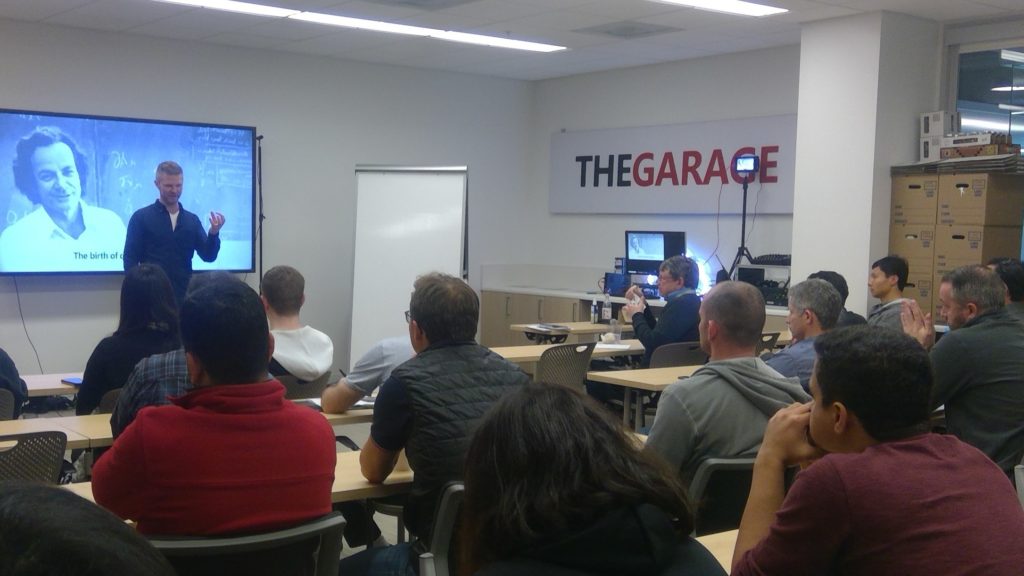
(Our Microsoft Bay Area quantum computing study group in our Sunnyvale office)
Innovation happening within the Bay Area is undeniable. In a region known for disruption, Microsoft employees here have a finger on the pulse of technology that can change the world.
Kitty Yeung joined Microsoft as a creative technologist and Bay Area manager of The Garage back in 2018. When she joined there was a strong and growing interest in quantum computing among her local colleagues. As program manager for The Garage, Yeung drives forward a culture of innovation within Microsoft. With that charter, and a PhD in applied physics from Harvard, she set out to create a community focused on understanding this new technology.
Yeung began researching materials on quantum computing. She found it either too corporate, as in press releases, or technically dense, as in academic textbooks. She decided to talk to other Microsoft employees — highly technical hardware and software engineers, many of them with physics backgrounds — about their understanding. Yeung found they too were having a hard time grasping the basics of quantum computing with the information available to them.
She then called quantum expert Mariia Mykhailova, a senior software engineer on Microsoft’s Quantum Software team. Mykhailova’s group is working to build out Q# (Q-sharp), a first of its kind high-level quantum-focused programming language. Together, along with Garage colleagues at other global sites, they decided to create a community around quantum computing that would raise awareness for the technology both inside and outside the company.
A learning program and course for quantum computing was soon developed. Yeung sent out first invitations to employees in the Bay Area, and more than 400 people signed up. Her kickoff meeting in the middle of 2018 attracted more than 100 participants. She’s held three recurring tracks of beginner classes on quantum computing concepts and basic Q# programming since then. The study group now has an advanced class and there are chapters across the globe within Microsoft. Speakers crossover from The Garage in India, Sunnyvale, and Redmond. Hackathon projects further connect the groups, all of which focus on driving a deeper understanding of the technology.
“Many people joined the group because they’re intellectually curious and want to learn something challenging,” Yeung says. “And some people are seeking opportunities in new fields filled with promise. They are developing their skills in this programming language to better prepare themselves for the future.”
A game-changing technology
The potential applications of quantum computing are immense. The tremendous processing power and speed could drive breakthroughs in medicine, climate science, economics, and countless other fields.
At a recent Fortune event, Krysta Svore, Microsoft’s general manager of quantum software, said quantum computing could help solve the world’s most urgent problems. She said the technology will allow us to do things like capture “carbon from the atmosphere to save the planet” and “improve clean energy and food production.”
However, a lack of qualified professionals to further this important technology is impeding progress. Svore noted that currently, “there are not enough people educated in the space” to meet demand.
The Bay Area Quantum Computing Group aims to help with that. “When you are building a new technology, the technology itself isn’t enough,” Yeung says. “You have to evangelize it. People must start using it. Growing a community is essential to driving further development.”
(Bela Bauer, principal research manager, stops by from our Station Q lab to share quantum computing insights with our Bay Area group)
Interests and ideas converging
Sameer Sathe is a design verification engineer on the local Silicon team, developing custom chips and processors for Microsoft hardware products. He joined the group early on and has since graduated from quantum computing student to instructor. Sathe sees the group as a great way to bring people from different fields and disciplines together to focus on a common passion.
He initially joined the Bay Area Quantum Computing group because the speed at which quantum technology will be able to process compute-heavy applications, like with weather forecasting and cryptography, piqued his interest. He soon found that with his hardware background, he could even help the group understand the difference between classical and quantum computing, two radically different computing techniques. Sathe believes that widespread application of the technology could easily lead to a revolution in computing.
“I love the diversity of opinions. The group brings together people with varying ideas about how we can apply quantum computing.” – Sameer Sathe, design verification engineer
Sathe continues to meet new people every class he teaches. They always view applications and uses differently, and he enjoys brainstorming potential solutions with them that leverage the power of quantum computing. “The software team just thinks about it so much differently than I do as a hardware (design verification) engineer,” Sathe says.
Moving from familiar to unexplored territory
Mario Inchiosa, a principal software engineer on the AI customer engineering team (ACE) for Microsoft’s Azure AI platform, is another member of the group. He earned his PhD in physics at Harvard and remembers putting together a proposal for a quantum computing project as long ago as 1999.
Inchiosa retained his curiosity about quantum computing, but lost touch in recent years — until last summer, when he joined the study group and started using Microsoft’s Quantum Development Kit (QDK), which were released in December 2017. “I downloaded it and started to read through the documentation so I could play with it,” Inchiosa says. “But it was extremely technical. I tried to remember my quantum mechanics from decades ago, and thought, ‘this won’t be easy.’”
His re-introduction to the technology spurred interest in further understanding. At the One Week global hackathon last year, Inchiosa registered for a project to create learning materials for quantum computing and the Q# language. It was a project that Mykhailova had submitted with Yeung to create new tutorials for the recently launched Quantum Katas — a series of self-paced tutorials geared toward helping people with minimal knowledge of the topic learn quantum programming. Inchiosa chose to develop a kata on superdense coding — a way of transmitting two bits of classical information by sending just one quantum bit.
He ended up writing several exercises, which were reviewed and further improved upon by members of Microsoft’s quantum computing team. In July 2019, Microsoft open-sourced the QDK so the broader quantum computing community could contribute. Opening up the QDK allowed for faster contributions to apps and algorithms, along with innovations around compilation, optimization, and tooling. Now anyone, Mario included, is able to improve upon the work of others.
(Michael Beverland, senior researcher in Microsoft Quantum, brings additional knowledge to our employees who are interested in learning more)
From a hobby to future career path
At this point quantum computing is still a hobby for many within the club. “But my day job is AI and machine learning. And we’re not far off in applying quantum computing to these technologies,” Inchiosa says. Medical imaging for instance is benefiting from quantum solutions. Doctors now have high-density MRIs capable of detail simply not possible with classical computing. For example, Microsoft’s “quantum-inspired” algorithms have allowed Case Western Reserve to create MRI scans three times faster than before. They’ve also achieved scans that are almost 30% more precise. Innovations like these can help clinicians find cancer earlier, and even eliminate the need for invasive procedures like biopsies.
“It speaks to the growth mindset here. Microsoft views its employees not as possessing one skill and one skill only, but as people who have the ability to grow.” – Mario Inchiosa, principal software engineer, AI customer engineering (ACE)
To further evangelize the insights and progress made by this group, Yeung is compiling the lessons into a book on quantum computing. The book will start with the basics, delve into building algorithms, and end with a summary of quantum computing hardware systems currently under development. “This is about science, and want to educate people,” she says. “We need to engage with the public, share what we have, and give them the education they need, so they’re able to use the technology when the hardware becomes available.”
Building and educating a community is critical to democratizing new technology. If you are interested in helping and becoming part of ours, Bay Area job openings can be found here – https://aka.ms/MicrosoftBayAreaCareers.
Available positions in our quantum computing group can be found here – https://aka.ms/AA6cmoz.




